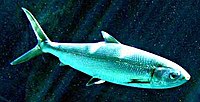Milkfish: Difference between revisions
No edit summary |
GrahamBould (talk | contribs) mNo edit summary |
||
| Line 15: | Line 15: | ||
| binomial_authority = ([[Peter Forsskål|Forsskål]], 1775) |
| binomial_authority = ([[Peter Forsskål|Forsskål]], 1775) |
||
}} |
}} |
||
The '''milkfish''' |
The '''milkfish''', ''Chanos chanos'', is an important food [[fish]] in [[Southeast Asia]]. It is the sole living [[species]] in the [[family (biology)|family]] '''Chanidae''' (about seven [[extinction|extinct]] species in five additional [[genus|genera]] have been reported). |
||
Milkfish have a generally symmetrical and streamlined appearance, with a sizable forked [[caudal fin]]. They can grow to 1.7 m, but are most often about 1 meter in length. They have no teeth, and generally feed on [[alga]]e and [[invertebrates]]. |
Milkfish have a generally symmetrical and streamlined appearance, with a sizable forked [[caudal fin]]. They can grow to 1.7 m, but are most often about 1 meter in length. They have no teeth, and generally feed on [[alga]]e and [[invertebrates]]. |
||
| Line 38: | Line 38: | ||
{{Symbols of the Philippines}} |
{{Symbols of the Philippines}} |
||
[[Category: |
[[Category:Chanidae]] |
||
[[Category:Fish of South East Asia]] |
[[Category:Fish of South East Asia]] |
||
Revision as of 19:22, 17 November 2006
| Milkfish | |
|---|---|

| |
| Scientific classification | |
| Kingdom: | |
| Phylum: | |
| Class: | |
| Order: | |
| Family: | Chanidae
|
| Genus: | Chanos Lacépède, 1803
|
| Species: | C. chanos
|
| Binomial name | |
| Chanos chanos (Forsskål, 1775)
| |
The milkfish, Chanos chanos, is an important food fish in Southeast Asia. It is the sole living species in the family Chanidae (about seven extinct species in five additional genera have been reported).
Milkfish have a generally symmetrical and streamlined appearance, with a sizable forked caudal fin. They can grow to 1.7 m, but are most often about 1 meter in length. They have no teeth, and generally feed on algae and invertebrates.
They occur in the Indian Ocean and across the Pacific Ocean, tending to school around coasts and islands with reefs. The youngest larvae live at sea for 2–3 weeks, then migrate to mangrove swamps, estuaries, and sometimes lakes, returning to sea to mature sexually and reproduce.
The larvae are collected from rivers and raised in ponds, where they can be fed almost anything and grow very quickly, then are sold either fresh, frozen, canned, or smoked.
The milkfish is also a national symbol of the Philippines, where it is called bangus. Because milkfish is notorious for being much more bony compared to other food fish in the country, deboned milkfish or "boneless bangus" has become popular and common in stores and markets. The province Pangasinan, particularly in the town of Bonuan is the main source where one can buy the most delicious species of milkfish.
References
- "Chanos chanos". Integrated Taxonomic Information System. 11 March.
{{cite web}}: Check date values in:|date=and|year=/|date=mismatch (help) - Froese, Rainer, and Daniel Pauly, eds. (2006). "Chanidae" in FishBase. May 2006 version.
- Froese, Rainer and Pauly, Daniel, eds. (2006). Species of Chanos in FishBase. May 2006 version.
- Froese, Rainer; Pauly, Daniel (eds.) (2006). "Chanos chanos" in FishBase. May 2006 version.
- Francisco José Poyato-Ariza, A revision of the ostariophysan fish family Chanidae, with special reference to the Mesozoic forms (Verlag Dr. Friedrich Pfeil, 1996)

